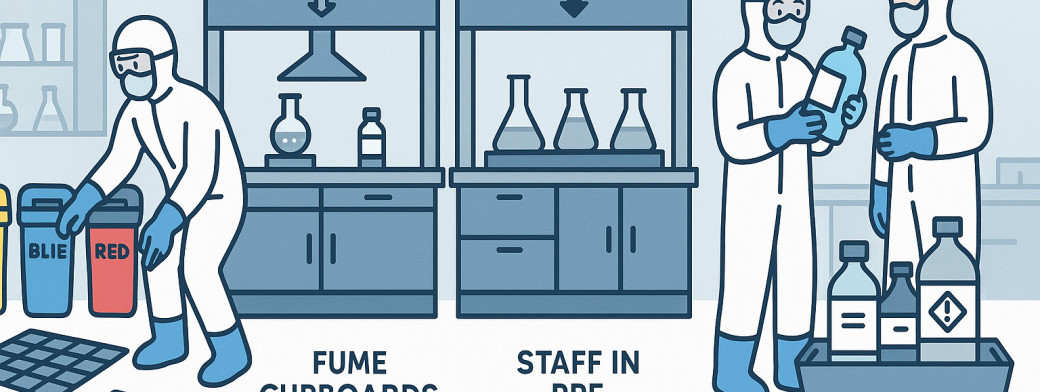
Spill Control in Laboratories: Safe Management of Chemical and Biological Spills
Introduction: The Importance of Spill Control in Laboratories
Spills in laboratories, whether they involve hazardous chemicals or biological materials, pose significant risks to staff, the environment, and ongoing experiments. Proper spill control is essential to mitigate these hazards, ensuring a safe working environment and compliance with regulatory frameworks.
Understanding the Hazards
Laboratories frequently handle a variety of hazardous substances, including:
- Acids and Bases: Corrosive and reactive, they can cause severe injuries and damage to surfaces.
- Solvents: Volatile organic compounds (VOCs) pose fire risks and health hazards.
- Biological Samples: Potentially infectious materials that can lead to contamination.
- Mercury: A legacy hazard that requires careful management due to its toxic properties.
- Radioactive Isotopes: Present additional risks and require stringent controls.
These hazards can lead to injuries, environmental contamination, and compromised research outcomes if not managed properly.
Regulatory Backdrop
In the UK, several regulatory bodies set forth guidelines to ensure safe laboratory practices, including:
- Health and Safety Executive (HSE): Enforces regulations under COSHH (Control of Substances Hazardous to Health) for hazardous chemicals.
- HSE Laboratory Biosafety: Provides requirements for handling biological materials safely.
- Environment Agency: Oversees hazardous waste management and drain protection obligations.
Laboratories must adhere to these regulations to protect staff, the public, and the environment.
Hazard Mapping: Identifying Risks in the Laboratory
Conducting a hazard mapping exercise helps identify potential spill points and high-risk areas, including:
- Fume Cupboards: High-risk for chemical spills due to handling of volatile substances.
- Benches: Common location for spills from various liquids.
- Storage Cabinets: Potential leak points for stored chemicals.
- Autoclaves and Cold Rooms: Risks associated with biological materials.
- Cryogens: Spills can lead to severe injuries due to extreme temperatures.
Controls: Selecting the Right Absorbents
Choosing appropriate absorbents is critical for effective spill management:
- Chemical-Resistant Absorbents: Necessary for acids and solvents.
- Oil-Only Absorbents: Suitable for oil spills.
- Universal Absorbents: Effective for aqueous solutions.
- Low-Lint, Non-Shedding Absorbents: Essential for sensitive experiments to avoid contamination.
Additional controls include bunded storage cabinets, drain covers, secondary containment for reagent bottles, and adequate PPE.
Spill Kit Strategy
Implementing a robust spill kit strategy is vital for swift response:
- Types of Spill Kits: Tailor contents based on laboratory type (chemical, biological, mercury).
- Placement: Position kits near fume cupboards, storage areas, and shared benches for easy access.
- Signage and Instructions: Ensure clear visibility and guidance for usage.
- Inspection Routines: Regular checks and restocking linked to lab audits.
Procedures & Training
Establishing clear procedures and training is essential for effective spill management:
- Standard Operating Procedures (SOPs): Develop SOPs for different spill types (acid/base, solvent, biohazard, mercury).
- Risk Hierarchy: Follow the steps: stop the source, evacuate if needed, ventilate, contain, clean, dispose, verify.
- Role-Specific Training: Provide tailored training for lab staff and students.
- Drills and Reporting: Conduct drills and implement near-miss reporting to enhance preparedness.
Waste Management & Evidence Collection
Proper waste management is critical following a spill:
- Segregation: Ensure contaminated absorbents are segregated (chemical, biological, mercury).
- Storage: Use UN-approved containers for hazardous waste.
- Consignment Notes: Maintain accurate records for waste disposal.
- Audit Logs: Document spill responses for auditing purposes.
- Photographic Evidence: Capture images of responses when appropriate for future reference.
Practical Tools: Sample Checklist & Decision Tree
Utilising practical tools can streamline spill response:
- Sample Spill Response Checklist: Create a checklist that outlines immediate actions for various spill types.
- Decision Tree Flow: Develop a simple flowchart to guide users on responses for chemical vs biological spills.
Case Vignettes: Realistic Scenarios
Scenario 1: Acid Spill During Titration
A researcher accidentally spills hydrochloric acid during a titration. The root cause was inadequate attention during the procedure. The response involved:
- Evacuating the area and securing the spill.
- Using appropriate absorbents to contain and clean the spill.
- Disposing of contaminated materials as per waste management protocols.
Audit Outcome: The lab improved training on handling corrosive materials and updated SOPs for titration.
Scenario 2: Biological Fluid Spill in a Research Lab
A researcher spills a biological fluid containing potentially infectious material. The root cause was improper handling of samples. The response included:
- Immediate evacuation and containment of the spill.
- Utilising biological absorbents to clean up safely.
- Documenting the incident for training and procedural updates.
Audit Outcome: The lab reinforced training on biological safety and enhanced spill kit contents for biological materials.
FAQs
- What absorbents should I use for acids vs solvents? Use chemical-resistant absorbents for acids and specific solvent absorbents for organic solvents.
- Are universal absorbents safe for biological spills? No, specific biological absorbents should be used to prevent cross-contamination.
- How should I handle small mercury spills? Use a mercury spill kit, ensuring PPE is worn, and follow specific procedures for mercury clean-up.
- What PPE is essential for spill response? At minimum, use gloves, goggles, and lab coats; additional PPE may be required based on the substance.
- How often should spill kits be inspected? Inspect spill kits at least monthly and after any use, ensuring they are fully stocked and in good condition.
- How can I train new lab users quickly? Conduct an introductory session covering essential safety practices and spill response protocols, supplemented with hands-on training.
Conclusion
Effective spill control in laboratories is paramount for ensuring safety, compliance, and the integrity of research. By implementing robust procedures, appropriate absorbents, and thorough training, laboratories can significantly reduce the risks associated with spills.
For tailored spill management solutions, consider SERPRO’s comprehensive UK range of absorbents and spill kits designed for laboratory use. Prioritising spill control not only protects your staff and environment but also enhances your laboratory’s operational efficiency.
